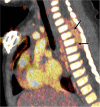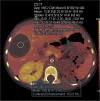Dual-Energy CT Material Decomposition in Pediatric Thoracic Oncology
- PMID: 33778757
- PMCID: PMC7983800
- DOI: 10.1148/rycan.2021200097
Dual-Energy CT Material Decomposition in Pediatric Thoracic Oncology
Abstract
Technical advances in CT have enabled implementation of dual-energy CT into routine clinical practice. By acquiring images at two different energy spectra, dual-energy CT enables material decomposition, allowing generation of material- and energy-specific images. Material-specific images include virtual nonenhanced images and iodine-specific images (iodine maps). Energy-specific images include virtual monoenergetic images. The reconstructed images can provide unique qualitative and quantitative information about tissue composition and contrast media distribution. In thoracic oncologic imaging, dual-energy CT provides advantages in characterization of thoracic malignancies and lung nodules, determination of extent of disease, and assessment of response to therapy. An especially important feature in children is that dual-energy CT does not come at a higher radiation exposure. Keywords: CT, CT-Quantitative, Lung, Mediastinum, Neoplasms-Primary, Pediatrics, Thorax, Treatment Effects © RSNA, 2021.
2021 by the Radiological Society of North America, Inc.
Conflict of interest statement
Disclosures of Conflicts of Interest: M.J.S. Activities related to the present article: disclosed no relevant relationships. Activities not related to the present article: disclosed money paid to author from Siemens Healthcare for travel and honorarium for lectures, including service on speakers bureaus. Other relationships: disclosed no relevant relationships. S.B. disclosed no relevant relationships. M.C. disclosed no relevant relationships.
Figures



















References
-
- Megibow AJ, Kambadakone A, Ananthakrishnan L. Dual-Energy Computed Tomography: Image Acquisition, Processing, and Workflow. Radiol Clin North Am 2018;56(4):507–520. - PubMed
-
- Rajiah P, Parakh A, Kay F, Baruah D, Kambadakone A, Leng S. Update on Multienergy CT: Physics, Principles, and Applications. RadioGraphics 2020;40(5):1284–1308. - PubMed
-
- Siegel MJ, Kaza RK, Bolus DN, et al. White Paper of the Society of Computed Body Tomography and Magnetic Resonance on Dual-Energy CT, Part 1: Technology and Terminology. J Comput Assist Tomogr 2016;40(6):841–845. - PubMed
Publication types
MeSH terms
Substances
LinkOut - more resources
Full Text Sources
Other Literature Sources
Medical

